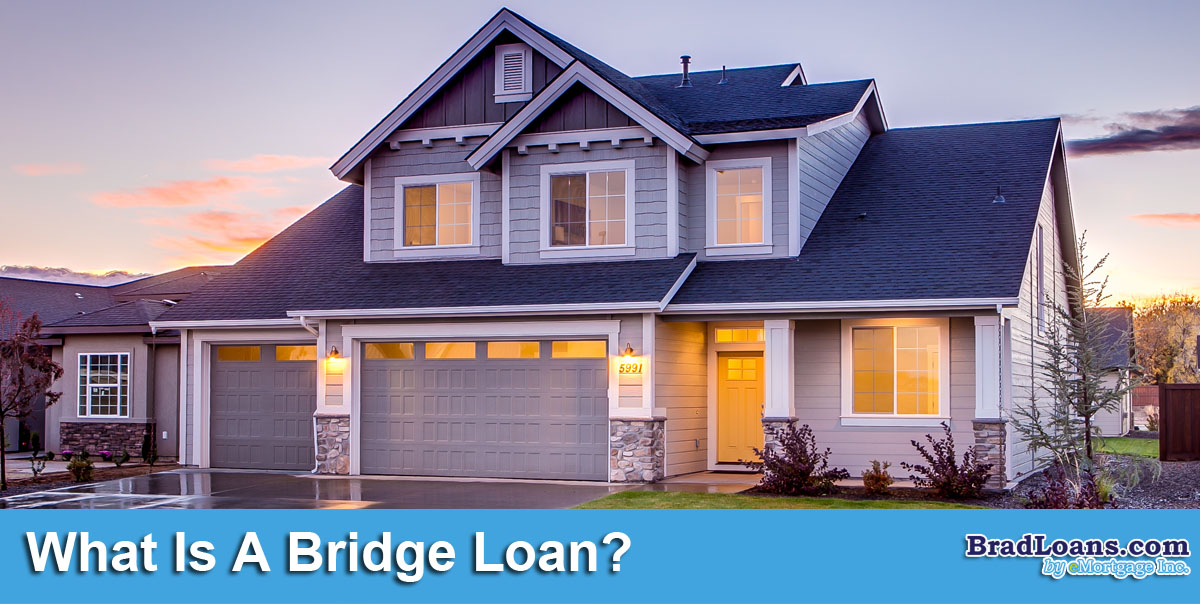
If your Googling “What Is A Bridge Loan“, this post should help clarify. Here Brad Loans by eMortgage Inc explains what a bridge loan is, how it works and what it is used for.
What is a bridge loan?
A bridge loan is a temporary loan that will bridge the gape between sales price of a new home and your new mortgage, if the old home hasn’t sold yet.
The bridge loan is secured to the existing home. The funds are then used as a down payment on the new home.
A bridge loan happens to be quite popular within a certain type of real estate market. Whether or not that it is a good option will depend on various factors. The reason that a buyer will take out a bridge loan is because they want to buy another place before they sell their existing home. That may sound great, but a bridge loan does have risks.
For instance, whenever a home buyer is purchasing another home before selling their home, there are 2 ways to find the down payment for the new home which is financing through a home equity loan or a bridge loan.
It is best to wait before buying a home and selling your home first, but most think its best to locate their move in home first.
If you are certain that your existing property will sell, then it will remove fears about what happens if it doesn’t. You may want to talk to an advisor before you get a bridge loan. The main advantage of a bridge loan is to avoid a bad offer and make the move up offer more attractive to a seller.
Normally, a home equity loan is much less expensive, but a bridge loan has more benefits for certain borrowers. Additionally, most lenders will not lend a home equity loan if the home is on the market. Smart borrowers will compare the benefits between the 2 types of loans and find which one is better for their situation and plan ahead before making an offer on another home.
A big benefit for bridge loans is that it allows you to purchase a new home without worrying about selling right away.
Is the balance off? The account balance that is. Below is how much money that you should keep within your savings and checking accounts.
Get it right! In the seller market, most sellers won’t accept a contingent offer. If you are selling a home, that may mean that you can’t buy a home without contingency.
How does a bridge loan work?
Most lenders will not have set debt to income ratios or FICO minimums guidelines. Funding is actually done with an underwriting approach. This requires guidelines in long term financing that is obtained for the new home.
There are some lenders that will make a conforming loan to exclude bridge loan payments for qualifying purposes. This means that you are qualified to buy the new home by adding your existing loan payment onto the new mortgage payment. The reasons that you may be qualified on 2 payments is because:
- For a short time, you will own 2 homes.
- Many buyers have an existing mortgage on old home.
- Buyer is likely to close new home purchase before selling old home.
If the new mortgage is a conforming loan, then lenders will have a bit more ways to be able to accept a much higher debt to income ratio by being able to run it through automated underwriting programs. If the new loan is a jumbo loan, then many lenders will restrict it to a 50% debt to income ratio.
Average fee for a bridge loan
Rates will actually vary between lenders, but below is an average estimate for a bridge loan in California. The interest rate will fluctuate, but for this instance, we will use 8.5%. These types of bridge loans will not have payments for 4 months, but interest will build up and be due whenever the loan has been paid based on the sale of the old property. Below are sample fees:
- Drawing/wire/courier fee: $75
- Recording fee: $65
- Notary fee: $40
- Title policy fee: $450 or more
- Escrow fee: $450
- Appraisal fee: $475
- Administration fee: $850
Additionally, there will be a loan origination fee for the bridge loan that is based on the loan amount. Each point will be equal to 1%. Below are the average fees and they will vary.
- $150,000 – $250,000 = 1 point
- $100,000 – $150,000 = 0.75 point
- $25,000 – $100,000 = 0.50 point
Home Purchasing Benefits of Bridge loans
- If there is a contingent offer to purchase, the seller has a Notice to Perform, then the purchaser may then remove any contingency and move forward with the purchase.
- The buyer can put their home on the market immediately and buy without restrictions.
- A bridge loan may not require a monthly payment for several months.
Home Purchasing Disadvantages of Bridge Loans
- Buyers are often qualified by a lender to own 2 homes and most may not meet this requirement.
- Making 2 mortgage payments plus interest on a bridge loan may cause stress
- Bridge loans will cost much more than a home equity loan.
Bridge Loans In Arizona
If you are looking for bridge loans in Arizona, Brad Loans by eMortgage can help. We offer bridge loans, hard money loans and fix and flip loans in Phoenix, Arizona and the sourounding cities.





